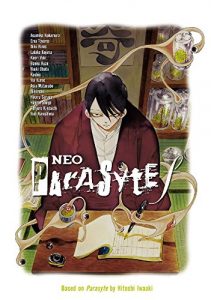By Various Artists, based on the manga created by Hitoshi Iwaaki. Released in North America by Kodansha Comics. Translated by Kumar Sivasubramanian
I have fond memories of Parasyte, despite never having actually read it. It was one of the first four titles that Tokyopop put out when it began, along with Sailor Moon, Magic Knight Rayearth, and the long forgotten Ice Blade. Unlike Ice Blade, Tokyopop actually finished the series, but it was always a sort of cult hit over here, known mainly for its odd sense of humor and its startling decapitations. I was pleased when Kodansha decided to release the updated Japanese version in 8 volumes, and that sold considerably better than the first time around, as the market was much better prepared for it. And now we have this anthology, which on the face of it is even more bizarre: taking a horror series that runs in a seinen magazine and giving it to various Japanese shoujo creators, to see what they make of it.
Of course, anyone who knows Japanese shoujo knows that they are very familiar with the horror genre. Indeed, some of the artists in this anthology are best known over here for their shoujo gore, such as Kaori Yuki, whose tale of a twisted love triangle and a spoiled princess would not feel out of place in her other works. Parasyte filled a number of niches, and this anthology does a very good job of showing off why people liked it. There’s actually very little pure horror, as for the most part the artists try to do their own thing. As you’d expect given the genre, there are quite a few high school romances in here, some tragic, some heartwarming, and some with a twist that is both predictable yet also startling – Parasyte’s stock in trade. Miki Rinno’s story of a genki girl whose mind has broken a bit by the slaughter of her family as well as a parasyte inside her is particularly good.
That said, I think it may be the humor that draws in readers, and there’s a lot of that. From a fujoshi who uses her Parasyte to pair up hot guys (by Ema Toyama, the author of Missions of Love), to Parasyte cooking shows and otome games, there’s a lot of simply having fun with the premise. And for those who wonder if it’s all original characters, fear not: Shinichi and Migi are sprinkled throughout the book. Indeed, the story by Mikimaki of Migi shifting himself into various shoujo girls may be the funniest in the book. And sometimes I laughed even when I may not have been supposed to – Asia Watanabe’s somewhat disturbing take of a young girl in the thralls of puberty and her teacher, a priest (both of whom harbor parasytes) features a dizzy blonde girl named Luna, and it’s impossible not to see her as Luna Lovegood from the Harry Potter books.
So if you loved Parasyte, you’ll get a kick out of this book. But even if, like me, you never actually read the original, you may still find something here. The art is striking throughout, and there’s a lot of really good stories – I hadn’t even talked about the story by Kashio about a telepath who runs into a transfer student with a parasyte, which is tense and thrilling. I’d love to see more of these Anthologies from Western publishers.


Speak Your Mind